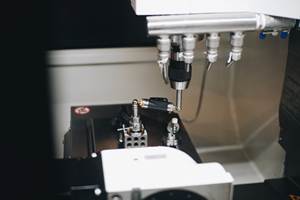Hard Turning And Cylindrical Grinding Were Made For Each Other
Combining different machining processes on the same platform has been a major theme in machine tool design for two decades or so. The Studer S242 combines cylindrical grinding and hard turning. A look at this machine shows that both of these machining processes benefit when they share the same platform.
Share






Combining different machining processes on the same platform has been a major theme in machine tool design for two decades or so. Some of these ‚Äúmarriages‚ÄĚ resulted in strained relationships in which one or both processes were compromised. Not so, it seems, with the combination of hard turning and cylindrical grinding on one machine, as indicated by the Studer S242. This machine was recently introduced by Fritz Studer AG to the world market after its initial debut in Europe at EMO 2007. (Studer AG is represented in the U.S. by United Grinding of Miamisburg, Ohio). A look at this machine shows that hard turning and cylindrical grinding seem to need each other.
The inherent rigidity of a machine designed for precision grinding is ideal for hard turning because it allows this process to deliver the roundness, concentricity and surface finish on hardened workpieces for which it is noted. The vibration-damping characteristics of a precision grinding machine prolong the life of turning tools when machining hardened materials. Likewise, turning the hardened workpiece on the same machine benefits cylindrical grinding. The part holds its original centering. No distortions or uneven stock conditions will be introduced by an intervening heat-treating step, so grinding is more predictable. The consistency of hard-turning results allows the grinding cycle time to be reduced when the same turned surfaces are subsequently ground.
Of course, all of the productivity advantages of finishing a part in one setup also apply to a combined hard turning/cylindrical grinding machine.
However, according to the builder, the S242 was designed from the ground up to support both processes. For example, the Granitan epoxy- granite machine bed is slanted to promote the free fall of turning chips and has cast-in channels for the necessary chip conveyor.
The machine’s cross slides are arranged in parallel so that the modular grinding heads and turrets can be configured as desired. The modular units include four styles of OD heads (left or right, straight or angled), two styles of tooling turrets and an ID grinding turret that can have as many as three spindles. The machine can be configured with two cross slides (10 different combinations of heads and/or turrets) or with three cross slides (15 different combinations). See the box for other key specifications.
                                                          with two slides                         with three slides
Distance between centers                   400/1,000 mm                         800 mm
Machinable length                              400/800 mm                            600 mm
Swing diameter                                  185 mm                                   185 mm
Maximum workpiece weight               60 kg                                       60 kg
Grinding wheel size                            500 x 50 (63 with F5) mm        400 x 50 (63 with F5) mm
The tool turret (available with 8 or 12 positions) is not limited to turning tools. All 8 or 12 positions can be powered for milling, drilling or other operations.
Customers in Europe are already providing some interesting applications for this type of machine. In one case, the user had been machining armatures for electric motors on six conventional machines‚ÄĒa lathe for thread cutting, another for turning the collector packets and laminate cores and four different grinders to do four ODs on the shaft. Now, the armatures are completed on an S242 in one setup by one operator. Moving to a single clamping has also reduced runout on the shafts and armatures, resulting in quieter, cooler-running electric motors.
Related Content
Orthopedic Event Discusses Manufacturing Strategies
At the seminar, representatives from multiple companies discussed strategies for making orthopedic devices accurately and efficiently.
Read MoreBallbar Testing Benefits Low-Volume Manufacturing
Thanks to ballbar testing with a Renishaw QC20-W, the Autodesk Technology Centers now have more confidence in their machine tools.
Read MoreLean Approach to Automated Machine Tending Delivers Quicker Paths to Success
Almost any shop can automate at least some of its production, even in low-volume, high-mix applications. The key to getting started is finding the simplest solutions that fit your requirements. It helps to work with an automation partner that understands your needs.
Read MoreInside a CNC-Machined Gothic Monastery in Wyoming
An inside look into the Carmelite Monks of Wyoming, who are combining centuries-old Gothic architectural principles with modern CNC machining to build a monastery in the mountains of Wyoming.
Read MoreRead Next
AMRs Are Moving Into Manufacturing: 4 Considerations for Implementation
AMRs can provide a flexible, easy-to-use automation platform so long as manufacturers choose a suitable task and prepare their facilities.
Read MoreMachine Shop MBA
Making Chips and Modern Machine Shop are teaming up for a new podcast series called Machine Shop MBA—designed to help manufacturers measure their success against the industry’s best. Through the lens of the Top Shops benchmarking program, the series explores the KPIs that set high-performing shops apart, from machine utilization and first-pass yield to employee engagement and revenue per employee.
Read More





















